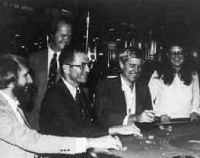Blackjack Card Counting - Play to Win by 'Cheating' at the Blackjack Tables
Our Recommended Casinos
| # | Bonus | Match | Review | |
|---|---|---|---|---|
| 1 |  | 100% | $250 | Get BonusRead Review |
| 2 |  | £50 | 100% | Get BonusRead Review |
| 3 |  | $1,500 | 200% | Get BonusRead Review |
| 4 |  | $400 | 100% | Get BonusRead Review |
| 5 |  | $1000 | 200% | Get BonusRead Review |
Contents:
Card Counting – The Man Who Started it All
As opposed to many popular beliefs, the blackjack card counting system was not invented during the early 20th century. Nor was it developed by a group of students at MIT or a genius gambler. The card counting technique was developed during the 1960’s by Dr. Edward Oakley Thorp, who is widely considered to be to be the creator of blackjack card counting – the way to beat the game of blackjack. A mathematics professor at MIT, Thorp was intrigued by blackjack following an article he had read in a journal. He decided to methodically study blackjack to find some way of gaining a statistical advantage based on the remaining cards in the shoe. After much effort Thorp managed to come up with a system that provided results that derived from the variations in the remaining cards after known cards were dealt. This is de facto the foundation of blackjack card counting. Thorp’s system boasted of taking away the house advantage of up to 5% (for the very worst strategies like mimicking the dealer or never busting) and giving the player an edge of 1%. In a world of generous deck penetrations and unsuspecting casino patrons this was indeed a formidable statement. Thorp deduced that educated guesses based on known cards can be made with regards to the remaining cards in the deck, thus increasing the accuracy of a player’s actions such as Hit, Stand, Double, Split, etc.
Following Thorp’s blackjack articles and fame he was joined by Manny Kimmel, a known mob accountant and blackjack and roulette enthusiast. Kimmel sensed the huge potential that was hidden in Thorp’s system and decided to apply them at the blackjack tables and acted as Thorp’s financer. After much practice and reparations the duo exploded on the Vegas casino scene and hit it big with an initial investment of $10,000. Thorp won $11,000 in a single weekend, which is $70,000 in today’s rates. Of course such winnings were rare and drew the attention of casino patrons, which resulted in repeated expulsions from several casinos every night. Nowadays casinos make sure that deck penetration is seldom more than 60% as a way to combat and discourage card counters. Due to the huge interest generated about spreading Thorp’s findings to a wider gambling audience he wrote the book Beat the Dealer Beat the Dealer in 1962 and its subsequent update in 1966. The book made Thorp's widely known ‘10-count system’ public, and was almost a step-by-step tutorial that trained the player to gain an edge in blackjack. Since then, all the leading card counting systems use Ed Thorp's theories as their basis.
Thorp also met and hooked up with American mathematician and engineer Claude Elwood Shannon, and together they would make weekend trips to Vegas, often returning with their pockets full of winnings from blackjack and roulette. They made a small fortune (according to the book Fortune's Formula Fortune's Formula) using a small wearable computer inside the casino (something that is now illegal) that predicted the outcome of the roulette (providing an expected gain of +44%), and game theory type methods co-developed with physicist John L. Kelly Jr. based on principles of information theory. Thorp and Shannon also applied the same theory (later known as the ‘Kelly criterion’) to the stock market, consequently writing the book Beat the Market. Thorp was one of the first seven inductees to the Blackjack Hall of Fame, a great honor to the man who revolutionized the game of blackjack with his theories and systems.
Another blackjack group took Thorp’s system and theories to the next level and reportedly won millions of dollars. That group is known as the MIT Blackjack Team.
Edward Oakley Thorp:
Degrees
- Ph.D. (Mathematics), University of California, Los Angeles, 1958
- M.A. (Physics), University of California, Los Angeles, 1955
- B.A. (Physics), University of California, Los Angeles, 1953
Published Books
- Beat the Dealer: A Winning Strategy for the Game of Twenty-One, Beat the Dealer: A Winning Strategy for the Game of Twenty-One
Random House, New York, 1962 (1966 2nd Ed.) ISBN 0-394-70310-3
- Elementary Probability, Wiley, New York, 1966
- Beat the Market: Beat the Market: A Scientific Stock Market System
A Scientific Stock Market System, (with Sheen Kassouf) Random House, New York, 1967 ISBN 0-394-42439-5
- The Mathematics of Gambling The Mathematics of Gambling
(Online Book), Gambling Times, 1984.

Ed Thorp at the Blackjack Tables

Claude Elwood Shannon
Shannon's Theory of Secrecy Systems
Count Cards – Take Money from the Casino
Ever since Thorp made his blackjack system public (and published his book Beat the Dealer in 1962 which sold over 700,000 copies) the game exploded unto the world. Card counting became the hottest buzzwords and it seemed everybody wanted to win in blackjack like Ed Thorp or at a later stage the MIT Blackjack Team.
Card counting, or counting the deck, is actually a process of gaining advantage by tracking the cards which have been played, so a player has better knowledge of the value of the cards remaining to be dealt. The main objective of card counting is to evaluate the remaining number of high-value cards versus low-value cards by keeping track of the known cards which have already been dealt. By practicing this method the card-counting player is able to discern which cards are left in the deck. Since it is difficult to memorize each and every card that was dealt (particularly in multiple decks games), counting methods divide cards to high and low. For example, the player’s advantage is expressed in the ability to make decisions that may change based on educated guesses. If a player has 16 and the dealer’s upcard is a ten-valued card (10, Jack, Queen, or King), the player wants to improve the hand and get as close as possible to 21 without busting (going over 21). If the player counted the cards up to this point and had discerned that the deck is denser with high-valued cards (i.e. 7, 8, 9, or 10-valued cards), then a logical decision would be to Stand. If the player had discerned that the deck is denser with low-valued cards (i.e. 3, 4, 5, or 6), then a logical decision would be to Hit. The dealer is bound by playing according to the table rules, i.e. hitting until reaching 17. Counting the cards gives the player a better insight of the outcome of his moves, therefore decreasing the casino’s statistical advantage and even gaining an advantage over the casino.
Successfully practicing card counting can be costly to casinos, and casinos don’t like losing money. Casinos’ response to card counting has mainly been to increase the number of decks from one deck (52 cards) to as much as eight decks (try counting and remembering 416 cards in real time). A rule of thumb is before trying to count cards familiarize with the basics of blackjack such as the blackjack basic strategy charts.
